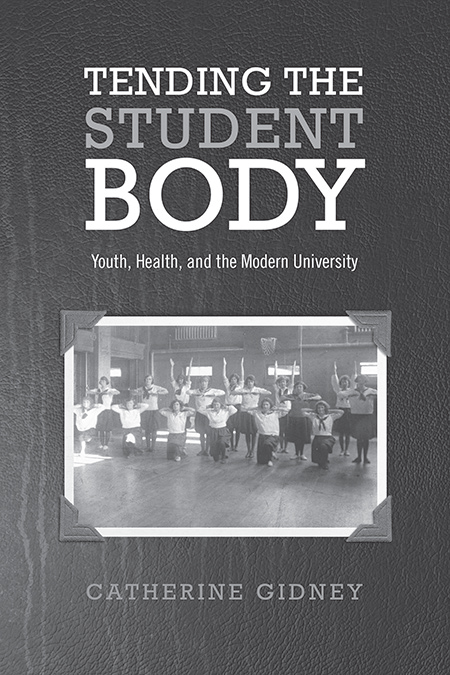Article body
In Canada, there is a relatively large body of scholarly work on the history of universities and higher education. This literature covers a variety of topics – institutional evolution, internal governance, student movements, relations with governments and external forces, etc. – and approaches these from a range of perspectives – faculty members, students, administrators, and staff. Catherine Gidney’s well-written and interesting monograph makes a significant contribution to this literature, as well as making important connections with the scholarship in a number of different fields.
Tending the Student Body is a history of health services and physical education programs at Canadian universities from the end of the 19th Century to the 1960s. In particular, Gidney examines the various values and beliefs that led administrators to implement particular policies and practices and how these evolved over time in response to changing societal conceptions of the purpose of the university, the role of health and physical activity, and definitions of masculinity and femininity. Her monograph is divided into two main sections: the first examines the creation and ideological underpinnings of student health programs from the late nineteenth century until the 1940s, while the second explores the expansion of these provisions from the 1930s to the 1960s and the larger changes that influenced this evolution. She argues that, “the concern about study health led to the creation of new sites through which administrators could exert their moral vision of the university and shape the student body” (9); this moral vision was concerned with developing students’ character. Throughout the monograph, she effectively explains the institutional changes occurring at Canadian universities during this time and connects these to the larger developments occurring in the fields of medicine, psychology, and physical education.
One of the great strengths of this book is Gidney’s in-depth and nuanced examination of gender and its relationship to health services and physical education provisions. Firstly, she explores the role that evolving conceptions of masculinity and femininity had on the various programs developed at Canadian universities and how these differed for men and women. In attempting to build the character of their students, which was defined in unique ways for men and women, administrators implemented vastly different services for their students based on gender. Secondly, Gidney examines the opportunities these programs created for female administrators. She includes an entire chapter on female health services and the occupational opportunities this created for women employed by the university; female administrators were charged with overseeing the unique programs created for their female students and thus found new opportunities and a separate space for themselves and their students. This is an enormous contribution to the literature, as most histories of Canadian universities overlook the existence of female administrators and fail to acknowledge the unique spaces they could create within their institutions.
However, Gidney largely fails to explore the differences that existed between universities throughout Canada and tells a story that appears universal. While she provides evidence from a number of different universities, her focus is largely on Victoria College at the University of Toronto. This is apparently because of the availability of archival sources, which limits the work of all historians. However, this overlooks the importance of region, institutional culture, religion, etc. to the emergence of programs designed to develop the moral character of students. She states that, “Central Canadian and denominational universities were more likely to have developed compulsory physical training and medical examinations in tandem” (34); however, this is only briefly mentioned in the conclusion of Chapter 1 and only serves to highlight an important gap in the analysis that would add greater complexity to the narrative being presented.
That said, Gidney does an excellent job connecting her discussion of specific health services and physical education programs to the larger societal developments occurring throughout the first half of the twentieth century. She examines, for instance, changing conceptions of the purpose of the university, which was once focused on developing the moral character of its students but became engaged in the training of professionals for participation in the labour market. This had a tremendous effect, she argues, on the provision of services that were largely aimed at the former purpose. Moreover, she locates her narrative within the changing ideas, morals, and values that shaped the wider Canadian society. This is particularly evident in her discussion of gender and the evolving conceptions of masculinity and femininity that influenced programs and services within universities. It is also evident, though, in her discussion of “character” and the ways this changed over the decades. Finally, she also makes a significant contribution to scholarly work related to the history of medicine by exploring the ways that administrators were influenced by shifting notions of health, the rise of psychology as a field of study, and the emergence of “experts” who eventually dictated the direction of programs and services on university campuses. As this wider societal context affected more than just higher education, Gidney’s exploration of these developments ensures that her book has a much wider significance for scholars in a variety of different fields.
Overall, Tending the Student Body makes a significant contribution to the scholarly literature. While its focus is on a relatively small set of provisions within Canadian universities from the late nineteenth century to the 1960s, Gidney effectively locates them within a much larger context and offers a nuanced examination of wider developments in Canadian society. Although greater analysis of the importance of local, regional, and institutional culture might have added additional layers of complexity, this monograph is nevertheless a key resource for scholars in a variety of areas.


